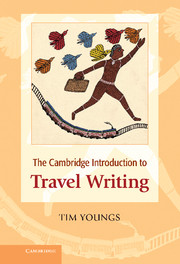Book contents
- Frontmatter
- Contents
- Figures
- Acknowledgements
- Chapter 1 Introduction
- Part I Historical overview
- Chapter 2 Medieval and early modern travel writing
- Chapter 3 Travel writing in the eighteenth century
- Chapter 4 Travel writing in the nineteenth century
- Chapter 5 1900–present
- Part II Continuities and departures
- Part III Writing and reading travel
- Notes
- Select Bibliography
- Index
Chapter 2 - Medieval and early modern travel writing
Published online by Cambridge University Press: 05 May 2013
- Frontmatter
- Contents
- Figures
- Acknowledgements
- Chapter 1 Introduction
- Part I Historical overview
- Chapter 2 Medieval and early modern travel writing
- Chapter 3 Travel writing in the eighteenth century
- Chapter 4 Travel writing in the nineteenth century
- Chapter 5 1900–present
- Part II Continuities and departures
- Part III Writing and reading travel
- Notes
- Select Bibliography
- Index
Summary
stirrers abroad, and searchers of the remote parts of the world.
Richard HakluytYou cannot discover an inhabited land.
DehatkadonsAntecedents
The origins of travel writing go back thousands of years. People have always travelled and told stories about their travels. As recorded on an Egyptian tomb, Harkuf, an emissary of the pharaohs in the third century BCE, was ‘the first long-distance traveler whose name we know’ and ‘the first one to leave a written account, or narrative, of his [four] journeys’. Modern travel literature has its roots in such older forms of writing: the factual record, as well as the mythical, the legendary and the ancient epics, including the four-thousand-year-old Gilgamesh from Mesopotamia, which was ‘widely known in the second millennium’ BCE, and through which ‘we are shown a very human concern with mortality, the search for knowledge, and for an escape from the common lot of man’. In it, the eponymous protagonist – part divine, part human king of Uruk – undertakes a journey through the Cedar Forest, suffers the death of his friend Enkidu and searches for ancestral wisdom and (in vain) for immortality (p.22). Gilgamesh is, Sanders observes, the ‘first tragic hero of whom anything is known’ (p.7). Lamenting that ‘Only the gods live for ever …, but as for us men, our days are numbered, our occupations are a breath of wind’ (p.71), Gilgamesh vows to go to the ‘country where the cedar is cut’ and to ‘set up my name where the names of famous men are written’ (p.72). His homecoming after his adventures, without attaining his goal of immortality, is prosaic but inscribes his name: ‘He went on a long journey, was weary, worn out with labour, and returning engraved on a stone the whole story’ (p.117).
Maria Pretzler hypothesises that ‘The tradition of written travellers’ accounts probably began with sea-farers’ logs, preserving information about distances, landmarks and harbours to facilitate orientation for future voyages’. These, she suggests, are probably the origin of the periplous, ‘an ancient genre of texts describing coastlines’. Among the periploi is the Carthaginian Hanno’s account of his voyage (probably in the early fifth century BCE) along the African coast, and Pytheas of Massalia’s Peri tou Okeanou (On the Ocean), which recorded his voyage to northwestern Europe, most likely undertaken in the 320s BCE, including a circumnavigation of Britain (MP, p.49).
- Type
- Chapter
- Information
- The Cambridge Introduction to Travel Writing , pp. 19 - 37Publisher: Cambridge University PressPrint publication year: 2013



